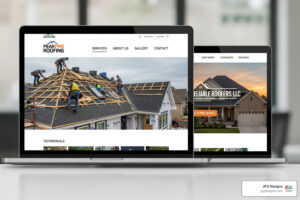In today’s digital age, having a website has become essential to running a successful small business. It serves as the online storefront and is often the first point of contact for potential customers. Therefore, ensuring your website delivers the best user experience while effectively showcasing your products or services is crucial. This post will outline the top 5 web design tips small business owners should consider when building or revamping their website, ultimately driving more sales and greater success.
Creating an attractive, user-friendly, and responsive website doesn’t have to be an overwhelming endeavor. Like anything else in business, it comes down to planning, proper execution, and ongoing maintenance. That’s why we’ve crafted this comprehensive guide for small business owners to follow—even if you’re not a web design expert, you can work with this list of crucial elements to ensure your website stands out and converts more visitors into loyal customers.
For businesses looking for achievable web design tips, we will explore topics about understanding your target audience, ensuring your website is accessible on various devices, focusing on user experience, and creating captivating content that resonates with your potential clients. By embracing these principles, you set the stage for a website that showcases your brand’s unique characteristics and appeals to your target audience while delivering a seamless and enjoyable experience from start to finish.
From choosing the right color schemes to simplifying navigation and increasing loading speed, we’ve outlined the most effective strategies to elevate your website and captivate visitors. So read on as we dive into the top 5 web design tips for small business owners that will make your website visually appealing and improve engagement, brand recognition, and ultimately, your bottom line.
1. Understand Your Target Audience
Before diving into the finer aspects of web design, it’s critical to identify and understand your target audience. The primary goal of your website is to appeal to your potential clients and encourage them to take action, whether purchasing a product or signing up for a service. To achieve this, tailor your website design to resonate with your audience.
Begin by researching and creating buyer personas representing your ideal customers. This information will help you define your site’s tone, style, and messaging. Moreover, consider your target audience’s demographics, geographic locations, challenges, and preferences when crafting your website’s design and content.
2. Prioritize Mobile Responsiveness
With the growing prevalence of smartphones and other mobile devices, web browsing, and online purchases are increasingly being made on the go. As a result, a mobile-responsive website is no longer optional. This means designing your website to adapt to various screen sizes and devices without compromising on layout, functionality, or user experience.
Consider a responsive design when building your website, allowing it to adjust to any screen size automatically, be it a desktop, tablet, or smartphone. Not only does this provide a seamless experience for visitors, but Google also ranks mobile-friendly websites higher in search results—making mobile responsiveness a must-have for effective SEO.
3. Simplify Navigation and User Experience
Your website’s navigation should be clear, straightforward, and user-friendly. Make it easy for your visitors to explore your site and find the information they’re seeking quickly. A confusing or complicated navigation structure can lead to high bounce rates, as users easily leave sites when they can’t find what they’re looking for.
To improve your site’s navigation, employ a clean and organized menu structure, limiting the number of primary navigation items to 5-7 options. Group related pages under easily understood categories to provide a clear path through your site. Remember, a user-centered design will lead to higher engagement and conversions.
4. Optimize Page Load Speed
Modern-day consumers demand instantaneous information. If your website takes too long to load, users are likelier to abandon it in favor of a faster, more efficient alternative. In fact, according to Google, 53% of mobile users will leave a site if it takes longer than 3 seconds to load. Optimizing your website’s load speed should be a high priority.
To increase your site’s loading speed, optimize your image sizes, enable browser caching, and minimize the use of plug-ins. Additionally, consider implementing a content delivery network (CDN), which uses geographically distributed servers to reduce load times by serving content from the server nearest to the user. Optimizing your page load speed will improve user experience and boost your website’s SEO rankings.
5. Choose Colors Strategically
The colors you choose for your website significantly impact audience perception and user experience. Picking the right color scheme can influence brand recognition and evoke certain emotions in your site visitors. To make informed decisions, consider color psychology, your brand identity, and your target audience when selecting your website’s color palette.
It’s essential to create contrast for readability, using lighter text on darker backgrounds or vice versa. Limit your website to three to five colors, choosing complementary hues that align with your brand personality. A consistent and carefully considered color palette will positively improve user experience and strengthen your brand identity.
Conclusion
In today’s digital world, a well-designed and user-friendly website is crucial for any small business owner looking to make an impact and drive results. By understanding your target audience, focusing on mobile responsiveness, simplifying navigation, optimizing page load speed, and choosing colors strategically, you can create an engaging, eye-catching, and effective website that appeals to your potential clients.
Remember that web design is an ongoing journey, and your site should be regularly updated to stay current and relevant. Monitor performance, gather user feedback, and keep up with industry trends and best practices to ensure your website remains a driving force for your small business. With a robust website design, you’ll unlock the potential for increased conversions, enhanced brand recognition, and greater success for your business.
JPG Designs is a web design company in Rhode Island, specializing in creating webpage designs for small-large businesses and nonprofit organizations. Get in touch with us to get a free consultation!





